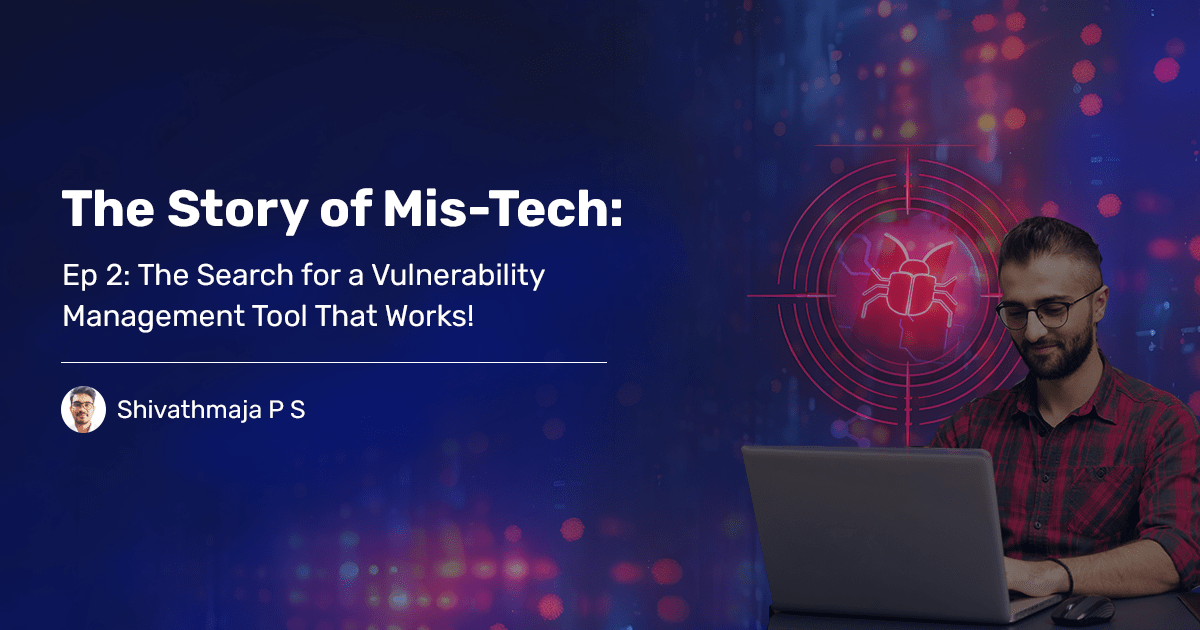A quick recap
In the previous episode, it’s a somber and serious scene at the Security HQ of Mis-Tech.
After the long, grueling days of facing the cyberattack, the team was slowly getting back to the normal routine.
It was rough on each one of them.
John, the CISO, was in a constant state of worry. Alice and Chris, the veterans of the team, were more proactive than before and Sid was still reeling from the experience of the first cyberattack of his career.
John had decided on a complete overhaul of their security systems, starting with their vulnerability management tool.
They needed to focus on how to prevent a cyberattack before it was too late. So, what they needed was preventive tools instead of reactive ones.
So, he decided on an urgent brainstorming session.
The Brainstorming Session
The agenda was clear: they needed a robust vulnerability management tool to prevent such breaches in the future. But John also wanted to make sure his team was able to work with it easily, and hoped to get everyone’s thoughts on it.
John stood at the whiteboard, marker in hand, as his team gathered. “We need to discuss what an ideal vulnerability management tool should look like,” he began. “Let’s go around the room and get everyone’s input.”
Alice was the first to speak. “I think real-time vulnerability assessments are the first thing we need. We can’t afford to wait for scheduled scans; we need continuous monitoring.”
Chris agreed and added his point as well, “I think the ideal vulnerability management tool should do more than just detection. Vulnerability management is detection + remediation. So, if the tool can do both, it’d be fantastic!”
“For me, automation is vital. If the tool detects and remediates, and if I’ll be able to automate the entire process, from scanning to patch management, my job would be so easy!” Sid, the youngest, said with a chuckle.
“I don’t want you to coast on your job, Sid, but you’re right,” John said sternly. He added, “This would reduce our workload and minimize your errors as well, Sid,” and a round of laughter went across the hall.
Ravi, the always-helping IT admin, nodded in agreement. He also added, “From the team’s learning standpoint, it should have a user-friendly interface. If the tool is too complex to navigate, it will slow us down.”
Bringing in the IT perspective, he also added, “Scalability is important too. Mis-tech is growing, and the tool should be able to scale with it as well
Finally, John said, “Lastly, I think the tool must provide comprehensive reporting and analytics. Clear, actionable insights are essential for us to understand our security posture and make informed decisions.”
The Ultimate Tier List of Features for a Vulnerability Management Tool
John split the list of features into three columns on the whiteboard: Must-have, Good-to-have, and Best-to-have.
“Let’s start with the must-haves,” he said. The team discussed and finalized some key essential features of their ideal vulnerability management tool:
- Real-time vulnerability assessments and monitoring
- Integrated risk scanning and patch management
- Multi-platform support (Windows, Linux, macOS)
- Up-to-date and comprehensive security risk database`
- Comprehensive reporting and analytics
Moving on to the good-to-have column, they added:
- Customizable dashboards
- Role-based access control
- Detailed vulnerability descriptions and remediation steps
- Seamless integration with existing infrastructure
For the If-not-no-problem column, they listed:
- Machine learning capabilities for predictive analysis
- Mobile device management
- Cloud environment support
The brainstorming session came to a close, and the team had a long list of features they wanted.
But would they be able to find a tool that could do it all?
Ticking the Boxes with SanerNow
With a good idea of what to look for in a vulnerability management tool, the team was ready for the search.
The team spent the next few days researching various vulnerability management tools. After careful consideration, they shortlisted a few, with SanerNow emerging as a strong contender.
John scheduled a demo to evaluate its features in detail.
During the demo, the guys from SanerNow explained how their tool approached vulnerability management.
“We follow the ‘Weakness Approach,’ which identifies weaknesses in your network that could potentially put your enterprise at risk. Then we prioritize risk based on their potential impact on your specific environment,” he explained. “This ensures that the most critical issues are addressed first.”
John was skeptical if the tool could do it all in their multi-OS network. But the rep countered, “SanerNow supports a bunch of platforms and can scale as your network grows. We support 40+ OSs and 450+ 3rd party applications as well.” he added.
Sid was impressed by SanerNow’s automation capabilities. “This will significantly reduce our manual workload,” he said, smiling.
Ravi added, “And the user interface looks intuitive enough for everyone to use without extensive training, too.”
The team was gradually becoming convinced with the capabilities of SanerNow.
John was particularly interested in the reporting capabilities. The demo highlighted how SanerNow CVEM provided detailed analytics and customizable dashboards. “This is exactly what we need for clear, actionable insights,” he said. He was impressed.
Conclusion
The demo was done, and the team was impressed. Sid looked around the room to see smiling faces.
John’s team was visibly impressed. SanerNow CVEM ticked almost all their boxes, from must-have features to some of the best-to-have enhancements.
“Looks like we found our vulnerability management tool,” Alice said with a smile. “Let’s go ahead with the trial and see how it performs in our environment.”
The team was looking forward to implementing SanerNow CVEM and seeing the impact.
They hoped SanerNow would fortify their defenses and prevent future cyberattacks.
Read on to see how they fared in the next episode of The Story of Mis-tech!




